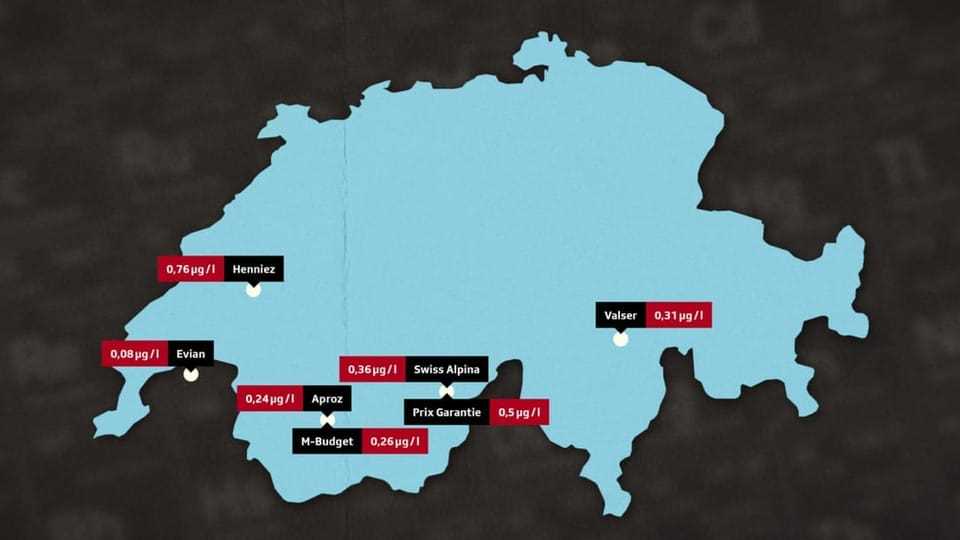contents
Swiss drinking water contains the problematic substance trifluoroacetate (TFA). Even bottled branded water. This is shown by samples from SRF Investigativ. TFA can hardly be filtered out. The EU is now having the substance examined for its dangerousness. Switzerland has been struggling so far.
Whether in medicines, coolants or pesticides: Trifluoroacetate (TFA) is found in countless chemicals. The substance has useful properties, for example it acts as a stabilizer. But it is precisely this resistance that is also the problem: as soon as TFA gets into the water, it does not break down there, but instead accumulates more and more. “TFA is very durable,” says Roman Wiget, water supplier in the Bernese Seeland, “the substance accompanies us throughout our lives.”
Tour de Suisse for water samples
In order to find out whether there is actually TFA in drinking water, SRF Investigativ took ten water samples between Lake Constance and Lake Neuchâtel. On drinking faucets in schools, community centers and museums. In addition, the editors had seven top-selling mineral waters from the retail trade analyzed.
TFA in school and community water
The “Technology Center Water” in Karlsruhe found TFA in all drinking water samples – with values between 0.51 and 1.5 µg/l (Values and statements see box). “It’s very similar to the situation in Germany,” says Karsten Nödler from the laboratory. Normally, higher concentrations would be measured in areas used intensively for agriculture.
The laboratory found one of the highest TFA values in Neerach. Like many others in Switzerland, the Zurich community has invested a lot of money in drinking water in recent years. For Mayor Markus Zink, clean water is a complex problem: “The manufacturer wants to sell chemicals, the farmer wants a good harvest and the population wants clean water.” This is a social dilemma that can only be solved together, and TFA is probably not the last chemical that can be detected in water.
Legend:
10 municipalities and their TFA values
SRF took water samples from these 10 communities. To classify the concentrations: In the case of pesticides, the authorities must check measures from a value of 0.1 µg/l. The German Federal Environment Agency recommends not to exceed 10 µg/l TFA in water, the guide value there is 60 µg/l.
SRF
There is no way around TFA. Because the laboratory commissioned by SRF also found TFA in all seven mineral waters, with values between 0.08 and 0.76 µg/l (Values and statements see box). This surprises the Association of Swiss Mineral Springs and Soft Drink Producers (SMS), “because natural mineral water comes from protected subterranean layers.”
Henniez has the highest concentration in the measurements. Nestlé Waters, to which Henniez belongs, writes: “TFA is not on any official list as a substance of concern and is not classified as a health hazard by the Swiss authorities.” Henniez is absolutely safe and can be drunk without hesitation.

Legend:
7 mineral water and their TFA levels
These mineral waters are among the best-selling in Switzerland. To classify the concentrations: In the case of pesticides, the authorities must check measures from a value of 0.1 µg/l. The German Federal Environment Agency recommends not to exceed 10 µg/l TFA in water, the guide value there is 60 µg/l.
SRF
On the radar in the EU
Trifluoroacetate is also referred to as a “forever chemical” because the substance cannot be filtered out of the water using established methods. The TFA concentrations in the water are only likely to increase in the future. The EU food authority EFSA is currently examining various substances that break down to TFA. There are concerns that TFA could harm the health of mammals, writes EFSA when asked by SRF. Germany also has a maximum value for TFA in water.
In contrast, the Swiss authorities have not yet systematically measured the environmental toxin in the water. Although the water research institute EAWAG recommended monitoring to the federal government in 2000 and TFA has been a topic in various reports since then.
What is Switzerland doing?
So far, TFA seems to have fallen between chair and bank with the Swiss authorities. The Federal Office for Food Safety FSVO, which is responsible for drinking water and pesticide approvals, mostly refers to the Federal Office for the Environment FOEN, which in turn only deals with ground and surface water. In a joint statement, they write that “an initial evaluation of the pollution situation for TFA” in lakes, rivers, groundwater and precipitation is currently underway. TFA has also been measured in the air on the Jungfraujoch since 2011 and there is an obligation to report refrigerants.
When asked whether a maximum value for TFA would be indicated, the FSVO and FOEN write: “If the FOEN’s measurement campaigns show widespread elevated values and this is also reflected in the drinking water catchments, the FSVO will re-evaluate the situation.”
Water supplier Roman Wiget is too slow: “The risks posed by such substances are systematically underestimated.” He and other water suppliers have been demanding for years that TFA should at least be included in the measuring program for groundwater monitoring. “It’s hard to understand,” says Wiget, “that this is still missing in Switzerland.”
